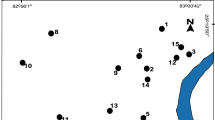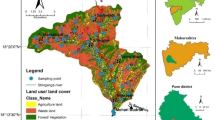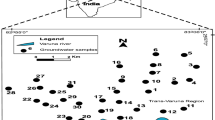Abstract
Today’s dual contamination (water–rock interaction and anthropogenic impact) in groundwater system is a common problem worldwide. Abundant amount of work has been carried out to assess groundwater quality; however, a very limited work is released towards delineation of fluoride zones by water–rock interaction (WRI) and anthropogenic causes.
For this reason, groundwater contamination problem has been taken up in a rural granitic hydrogeological setting of Andhra Pradesh, India. Agricultural activity, brick kiln factory and chicken farms are common anthropogenic sources available in the study area. A total of 53 groundwater and rainwater samples for monsoon months of the year 2006 have been collected and analysed. At various stages, corrections have been applied using chloride concentration limit (CCL) of 20 mg/l and fluoride concentration limit (FCL) of 1.88 mg/l. The results have proved that the dominant fluoride released by WRI action and anthropogenic action cover 15.1 and 21.7% area of the watershed, respectively. Also, present mixed state (WRI and anthropogenic causes) of groundwater quality covers the major portion of the watershed.
The results of these corrections have successfully discriminated groundwater samples based on present chemical constituents. Such studies are useful for creating awareness and planning remedial measures in contaminant watershed.
Similar content being viewed by others
References
APHA (1992) Standard methods for the examination of water and waste water, 18th edn. American Public Health Association, New York
Ahmed S, Sreedevi PD, Sujatha D, Hashimi SAR, Subrahmanyam K, Saxena VK (2002) Time variant behavior of fluoride contents of the granites aquifers. IGC, Dindigul, Tamil Nadu
Aller L, Bennet T, Lehr JH, Petty RJ, Hackett G (1987) DRASTIC: a standardized system for evaluating groundwater pollution potential using hydrogeologic settings. EPA-600/2-87-035, 622 p
Atal S (2009) Investigation of hydro-geochemical factors controlling excessive fluoride in granitic hard rock terrain: with special reference to Maheshwaram watershed, Andhra Pradesh. PhD thesis, Osmania University, p 251
Bricker OP, Jones BF (1995) Main factors affecting the composition of natural waters. In: Salbu B, Steinnes E (eds) Trace elements in natural waters. CRC Press, Boca Raton, pp 1–5
Chadha DK (1999) High fluoride ground water in India. Central Ground Water Board. Government of India, Faridabad, p 30
Datta PS, Deb DL, Tyagi SK (1996) Stable isotope (18O) investigations on the processes controlling fluoride contamination of groundwater. J Contam Hydrol 24:85–96
Denny SC, Allen DM, Journeay JM (2007) DRASTIC-Fm: a modified vulnerability mapping method for structurally controlled aquifers in the southern Gulf Islands, British Columbia, Canada. Hydrogeol J 15:483–493
Dewandel B Gandolfi JM, de Condappa D, Ahmed S (2008) An efficient methodology for estimating irrigation return flow coefficients of irrigation crops at watershed and seasonal scales. Hydrol Process 22:1700–1712
Drever J (1982) The geochemistry of natural waters. Prentice Hall, Englewood Cliffs, p 388
Durum WH, Haffty J (1961) Occurrence of minor elements in water. US Geol Surv Circ 445:11
Engerrand C (2002) Hydrogeology of the weathered-fissured hard rock aquifers located in monsoon areas: hydrogeological study of two watersheds in Andhra Pradesh (India). PhD thesis, University of Paris VI, France
Falkenmark M (2005) Water usability degradation—economist wisdom or societal madness? Water Int 30(2):136–146
Foster SSD, Hirata RCA (1988) Groundwater pollution risk assessment: a methodology using available data. WHO-PAHO-CEPIS Technical Report (Lima-Peru), 73 pp
Gaciri SJ, Davies TC (1993) The occurrence and geochemistry of fluoride in some natural waters of Kenya. J Hydrol 143:395–412
Garrels RM, McEnzie FT (1971) Evolution of sedimentary rocks. WW Norton, New York, 251 p
Gotham E (1961) Factors influencing the supply of major ions to inland waters with special influence to the atmosphere. Am Geol Soc Bull 72:795–840
Grosbois C, Négrel P, Fouillac C, Grimaud D (2000) Dissolved load of the Loire River: chemical and isotopic characterization. Chem Geol 170:179–201
GSI (2002) Geological map: Hyderabad quadrangle—Andhra Pradesh. Geological Survey of India
Hem JD (1959) Study and interpretation of the chemical characteristic of natural water. US Geological survey water supply paper no 1473, 269 p, Washinton, DC
Hem JD (1985) Study and interpretation of the chemical characteristic of natural water. US Geol Surv water supply paper no 2254, 264 p
Hem JD (1989) Study and interpretation of the chemical characteristics of natural waters. US Geol Surv Water Supply Pap 2254:263
Jacks G, Bhattacharyaa P, Chaudhary V, Singh KP (2005) Controls on the genesis of some high-fluoride groundwaters in India. Appl Geochem 20:221–228
Kim YJ, Hamm S-Y (1999) Assessment of the potential for groundwater contamination using the DRASTIC/EGIS technique, Cheongju area, South Korea. Hydrogeol J 7:227–235
Kumar D (2004) Conceptualization and optimal data requirement in simulating flow in weathered-fractured aquifers for groundwater management. PhD thesis, Osmania University, Hyderabad, 263 p
Likens EG, Bormann FH, Pierce RS, Eaton JS, Johnson NM (1977) Biogeochemistry of a forested ecosystem. Springer, Berlin
Lowe M, Butler M (2003) Groundwater sensitivity and vulnerability to pesticides, Herber and Round Valleys. Watsach County, Salt Lake City, UT, Utah Geological Survey
Madhavan N, Subramanian V (2002) Fluoride in fractioned soil samples of Ajmer district, Rajasthan. J Environ Monit 4:821–822
Mahavi AH, Nouri J, Babaei AA, Nabizadeh R (2005) Agricultural activities impact on groundwater nitrate pollution. Int J Environ Sci Tech 2(1):41–47
Maréchal JC, Dewandel B, Ahmed S, Galeazzi L, Zaidi FK (2006) Combined estimation of specific yield and natural recharge in a semi-arid groundwater basin with irrigated agriculture. J Hydrol 329:281–293
Meybeck M (1983) Atmospheric inputs and river transport of dissolved substances. IAHS Publ 141:173–192
Milliot G (1970) Geology of clays. Springer, New York, p 429
Morris BL (1994) Tools in a national groundwater protection policy: the National Aquifer Vulnerability Mapping Programme in England and Wales. In: Proceedings of the 2nd Latin American Groundwater Hydrology Congress, 7–11 November 1994, vol 3, pp 121–138
Négrel P, Allégre CJ, Dupré B, Lewin E (1993) Erosion sources determined by inversion of major and trace elements ratios and strontium isotopic ratios in river water: the Congo basin case. Earth Planet Sci Lett 120:59–76
Négrel P, Pauwels H (2003) Interaction between the different water bodies in catchments in Brittany (France): characterizing multiple sources in waters through isotopic tracing. Water Air Soil Pollut 151:261–285
Pandey OP, Agrawal PK, Chetty TRK (2002) Unusual lithospheric structure beneath the Hyderabad granitic region, eastern Dharwar Craton, South India. Phys Earth Planet Inter 130:59–69
Piper AM (1944) A graphical procedure in geochemical interpretation of water analysis. Am Geophys Union Trans 25:914–923
Rao NS (1997) The occurrence and behaviour of the groundwater in the lower Vamsadhara basin, India. Hydrol Sci J [J Sci Hydrol] 42:877–892
Rhine Commission (1975) Rapport de la Commission Internationale pour la Protection des Eaux du Rhin contre la Pollution, Koblenz
Roy S, Gaillardet J, Allégre CJ (1999) Geochemistry of dissolved and suspended loads of the Seine River, France: anthropogenic impact, carbonate and silicate weathering. Geo-chim Cosmochim Acta 63:1277–1292
Shahid S (2000) A study of groundwater pollution vulnerability using DRASTIC/GIS, west Bengal, India. J Environ Hydrol 8:124
Smith PA, Scott HD, Fugitt T (1994) Influence of geographic database scale on prediction of groundwater vulnerability to pesticides. J Soil Contamin 3(3):1–14
Sreedevi PD, Ahmed S, Made B, Ledoux E, Gandolfi JM (2006) Association of hydrogeological factors in temporal variations of fluoride concentration in crystalline aquifers in India. Environ Geol 50:1–11
Subba Rao N, Krishna Rao G, John Devadas D (1998) Variation of fluoride in groundwaters of crystalline terrain. J Environ Hydrol 6:1–6
Subrahmanyam K, Ahmed S, Dhar RL (2000) Geological and hydrogeological investigation in the Maheshwaram watershed, RR Dist, AP, India. Techical report no: NGRI-2000-GW-292
Sukhija BS, Nagabhushanam P, Reddy DV (1996) Groundwater recharge in semiarid regions of India: an overview of results obtained using tracers. Hydrogeol J 4:50–71
Susheela AK (2000) A treatise on fluorosis, 1st edn. Fluorosis Research and Rural Development Foundation, New Delhi
Tegyey M (2001) Etude petrographique de 29 lames minces de Roches Provenant d’Inde, BRGM, France. Technical report, 45 p. CDG/CG/MT/jb/2001-NT-048
Viswanathana G, Jaswantha A, Gopalakrishnanb S, Sivailangoc S (2009) Mapping of fluoride endemic areas and assessment of fluoride exposure. Sci Total Environ 407:1579–1587
Vörösmarty CJ, Meybeck M, Fekete B, Sharma K, Green P, Syvitski JPM (2003) Anthropogenic sediment retention: major global impact from registered river impoundments. Global Planet Change 39:169–190
Widory D, Kloppmann W, Chery L, Bonnin J, Rochdi H, Guinamant J-L (2004) Nitrate in groundwater: an isotopic multi-tracer approach. J Contam Hydrol 72:165–188
Author information
Authors and Affiliations
Corresponding author
Rights and permissions
About this article
Cite this article
Atal, S., Négrel, P., Pauwels, H. et al. Double Correction Technique for Characterising Groundwater Quality Zones: A Case Study from Granitic Setting, India. Water Qual Expo Health 2, 133–146 (2011). https://doi.org/10.1007/s12403-010-0031-6
Received:
Revised:
Accepted:
Published:
Issue Date:
DOI: https://doi.org/10.1007/s12403-010-0031-6




